Mk.558
Well-known member
Let's start right off. The Rocket is already installed, software already good to go. Off to the races first with System 6. Let's hope the images don't go down because I won't have backup copies.

Radius Rocket under System 6 with RocketWare control panel.
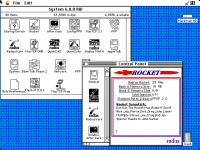
Showing Rocket information. It's actually a Rocket 33. All that QuickCAD and Radius MATH comes default.
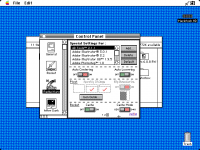
The RadiusWare control panel is usually intended for Radius display cards and monitors. Here, there's another view that shows Rocket cache settings.
Let's move on to System 7.1 with RocketWare 1.5.
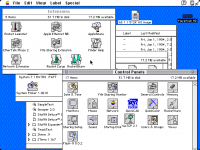
Everything relevant is here. RocketWare cannot run while RocketShare is active. Both are installed at the moment, although as you see in the upper right corner, RocketWare is active.

The main RocketWare control panel, with Rocket info window open. No idea what happens when you have more than one Rocket. Turning off the Startup Screen makes the 2nd reboot happen quicker. (In System 6, it takes about 25 seconds to boot from power-on to desktop. System 7 is slightly slower.)
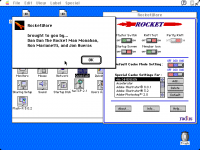
About... dialog. Cool icon.
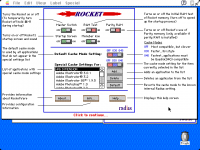
Help window. (It's just a PICT image. You can see it in ResEdit.)

QuickColor and QuickCAD control panels. QuickColor is for enabling the hardware video acceleration feature of the Rocket, among other hardware video accelerators -- a Radius display card must be installed. QuickCAD is for certain CAD programs which have specific math instructions that the Rocket can handle quicker than stock systems. As you see, the Rocket disables virtual memory. It also makes Disk Copy think there is no floppy drive installed.
Let's move on to RocketShare.

Mission Control program, Edit menu.
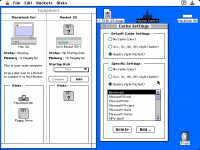
Showing main window and Cache Settings.

Preferences.
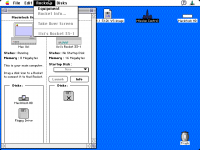
Rockets menu.
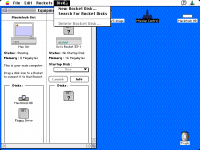
Disks menu.

Because of space reasons I had to delete the default Rocket Disk that you can install along with the Installer. It's about 6.5MB and includes a bootable startup folder. I needed the space at the time for other matters, so let's create a new one now.

Afterwards, it gets mounted to the desktop, where you can copy things to it like any normal volume.
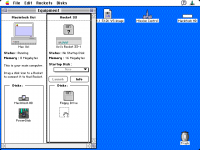
When you're done, you just unmount it, drag the disk to the Rocket, along with any other devices like the FDD, CD drive, another SCSI volume, etc to the Rocket.
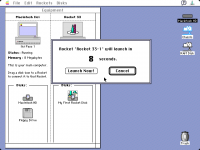
It's time for liftoff. Press Launch to start the Rocket. I just love that "Launch Now!" text -- has a hint of enthusiasm to it. It plays the same "whoosh" sound that RocketWare plays when it switches over to the Rocket.
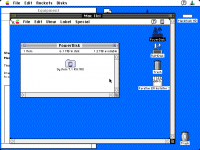
Active and ready for duty.

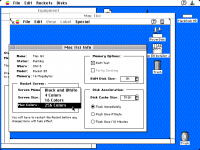
Rocket info. Has to be restarted between changes.
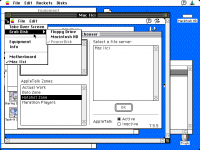
The little Rocket menu has shortcuts. Mainly for when you let it take control of the entire display.
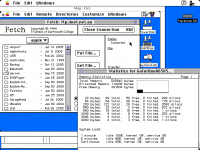
I had determined to figure out some way of getting it online inside the Rocket. Previously I have been told it is quite difficult. Mainly, because of the way the Rocket works, it can make a large number of NICs worthless. Enter the Cayman Systems GatorBox. Add MacTCP 2.1 and ... what compatibility problem?
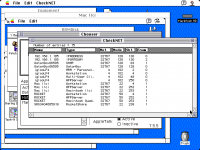
CheckNET showing all the units involved. iglooLF4 is my iMac G4 using 9.2.2.
What happens when things go wrong? Well, conveniently enough, my DSP card ate the dust, and I was using composite SIMMs. Last one is a no-no.
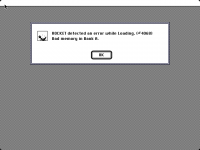
With RocketWare. Shows this dialog after all the INITs and CDEVs are loaded.
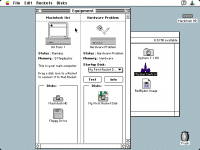
RocketShare. The crashed and broken rocket made me chuckle the first time I saw it.
Impressions?
Well, under System 6, it's awesome. Bullet-train feel. You know you're cooking with gas. System 7 is a little slower. Part of it is that System 7, with its many improvements, is still slower than System 6. I think you'll be more likely to convince yourself there *is* an improvement in System 7 with just day-to-day casual stuff because of the Placebo Effect. Does it make a difference? Yeah, probably 10-20%.
The Rocket is more or less aimed for people who used their machines for work. The best example I can think of is when you'd have a SCSI image scanner attached, with an external HDD off the same SCSI bus running off a SCSI-2 Rocket daughtercard. Add 32MiB of RAM, and you can offload all that dirty CPU intensive work to the Rocket using RocketShare.
I was using the IIci's vampire video. You won't want to do that. The lag you get in RocketShare is annoying.
The manual says 4MiB of RAM is the minimum the motherboard needs, which is true. In fact all you will be able to do is launch RocketShare and not much else. The IIci had 8MiB on board, as you saw, which is not enough, really. Upgrade it? That's a dicey proposition because this machine has those dreadful plastic SIMM clips. (That bean counter...) One clip is already broken off...probably best left alone.
I'm really happy that I got to play with one of these babies. They're not without their downsides (sound won't work inside RocketShare, networking via Ethernet is painful, ...) but I can finally tick this box off my list of Things To Play With. Also -- Achievement: Run System 6 on a 68040 processor.
Still, I did get networking going inside RocketShare, as you see. I don't think anything else will work, except IPNetRouter. As for networking via Ethernet and AFP, the Rocket under System 6 posted the fastest ever old Mac bitrate:
Have a great day!

Radius Rocket under System 6 with RocketWare control panel.

Showing Rocket information. It's actually a Rocket 33. All that QuickCAD and Radius MATH comes default.

The RadiusWare control panel is usually intended for Radius display cards and monitors. Here, there's another view that shows Rocket cache settings.
Let's move on to System 7.1 with RocketWare 1.5.

Everything relevant is here. RocketWare cannot run while RocketShare is active. Both are installed at the moment, although as you see in the upper right corner, RocketWare is active.

The main RocketWare control panel, with Rocket info window open. No idea what happens when you have more than one Rocket. Turning off the Startup Screen makes the 2nd reboot happen quicker. (In System 6, it takes about 25 seconds to boot from power-on to desktop. System 7 is slightly slower.)

About... dialog. Cool icon.

Help window. (It's just a PICT image. You can see it in ResEdit.)

QuickColor and QuickCAD control panels. QuickColor is for enabling the hardware video acceleration feature of the Rocket, among other hardware video accelerators -- a Radius display card must be installed. QuickCAD is for certain CAD programs which have specific math instructions that the Rocket can handle quicker than stock systems. As you see, the Rocket disables virtual memory. It also makes Disk Copy think there is no floppy drive installed.
Let's move on to RocketShare.

Mission Control program, Edit menu.

Showing main window and Cache Settings.

Preferences.

Rockets menu.

Disks menu.

Because of space reasons I had to delete the default Rocket Disk that you can install along with the Installer. It's about 6.5MB and includes a bootable startup folder. I needed the space at the time for other matters, so let's create a new one now.

Afterwards, it gets mounted to the desktop, where you can copy things to it like any normal volume.

When you're done, you just unmount it, drag the disk to the Rocket, along with any other devices like the FDD, CD drive, another SCSI volume, etc to the Rocket.

It's time for liftoff. Press Launch to start the Rocket. I just love that "Launch Now!" text -- has a hint of enthusiasm to it. It plays the same "whoosh" sound that RocketWare plays when it switches over to the Rocket.

Active and ready for duty.


Rocket info. Has to be restarted between changes.

The little Rocket menu has shortcuts. Mainly for when you let it take control of the entire display.

I had determined to figure out some way of getting it online inside the Rocket. Previously I have been told it is quite difficult. Mainly, because of the way the Rocket works, it can make a large number of NICs worthless. Enter the Cayman Systems GatorBox. Add MacTCP 2.1 and ... what compatibility problem?

CheckNET showing all the units involved. iglooLF4 is my iMac G4 using 9.2.2.
What happens when things go wrong? Well, conveniently enough, my DSP card ate the dust, and I was using composite SIMMs. Last one is a no-no.

With RocketWare. Shows this dialog after all the INITs and CDEVs are loaded.

RocketShare. The crashed and broken rocket made me chuckle the first time I saw it.
Impressions?
Well, under System 6, it's awesome. Bullet-train feel. You know you're cooking with gas. System 7 is a little slower. Part of it is that System 7, with its many improvements, is still slower than System 6. I think you'll be more likely to convince yourself there *is* an improvement in System 7 with just day-to-day casual stuff because of the Placebo Effect. Does it make a difference? Yeah, probably 10-20%.
The Rocket is more or less aimed for people who used their machines for work. The best example I can think of is when you'd have a SCSI image scanner attached, with an external HDD off the same SCSI bus running off a SCSI-2 Rocket daughtercard. Add 32MiB of RAM, and you can offload all that dirty CPU intensive work to the Rocket using RocketShare.
I was using the IIci's vampire video. You won't want to do that. The lag you get in RocketShare is annoying.
The manual says 4MiB of RAM is the minimum the motherboard needs, which is true. In fact all you will be able to do is launch RocketShare and not much else. The IIci had 8MiB on board, as you saw, which is not enough, really. Upgrade it? That's a dicey proposition because this machine has those dreadful plastic SIMM clips. (That bean counter...) One clip is already broken off...probably best left alone.
I'm really happy that I got to play with one of these babies. They're not without their downsides (sound won't work inside RocketShare, networking via Ethernet is painful, ...) but I can finally tick this box off my list of Things To Play With. Also -- Achievement: Run System 6 on a 68040 processor.
Still, I did get networking going inside RocketShare, as you see. I don't think anything else will work, except IPNetRouter. As for networking via Ethernet and AFP, the Rocket under System 6 posted the fastest ever old Mac bitrate:
That's hard to beat. Perhaps if you had a vaunted Daystar Turbo 040 at 40MHz...that'd be something to look at.iMac G4: 9.2.2, RAM Disk share, Ethernet
IIci: System 6.0.8, Rocket 33, Asante 10/100 NuBUS card, RAM disk for storage (HDD was the active OS volume)
IIci, downloading from the iMac G4: 866.5KiB/sec, 6.93Mbps
IIci, uploading to the iMac G4: 605.6KiB/sec, 4.84Mbps
Compared to the Rocket operating under System 7, same thing:
IIci, downloading from iMac G4: 332.7KiB/sec, 2.66Mbps
IIci, uploading to iMac G4: 256.7KiB/sec, 2.05Mbps
Have a great day!



